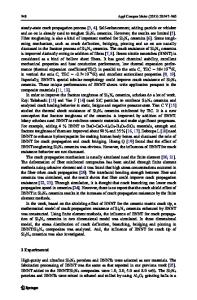Effect of Whisker Distribution on the Densification and Microstructures of AI 2 O 3 -Si 3 N 4 Composites
- PDF / 1,339,943 Bytes
- 6 Pages / 420.48 x 639 pts Page_size
- 30 Downloads / 352 Views
EFFECT OF WHISKER DISTRIBUTION ON THE DENSIFICATION AND MICROSTRUCTURES OF A1203-Si3N4 COMPOSITES W.J. TSENG AND P.D. FUNKENBUSCH Materials Science Program, Department of Mechanical Engineering, University of Rochester, Rochester, NY 14627. ABSTRACT This study focuses on (1) the co-dispersion behaviors of dissimilar phases exhibiting different surface chemistry in ceramic suspensions and (2) the effect of local whisker distribution on matrix densification. Si3 N4 whiskers and A120 3 powders are mixed and slipcast in aqueous solution. Local whisker clusters are observed and remain stable even after prolonged sintering. High shear-rate agitation of the composite suspension does not eliminate the whisker agglomeration. Surface pre-treatment of whiskers, such as acid/base-washing, effectively reduces the clustering and sintered flaw size. From SEM observation it is found that the matrix powder densifies highly inhomogeneously because of the constraint imposed by the reinforcement. Matrix powder is inhibited from diffusing into "inter-whisker" voids. INTRODUCTION New developments in structural applications in the advanced ceramic industry put tremendous demands on processing methods in order to obtain reliable ceramics with reasonable toughness and strength [1]. Among the materials of greatest interest, whisker reinforced ceramic composites offer versatile fabrication methods with improved toughness properties. However, discontinuous short whiskers, especially whiskers with small diameters and large aspect ratios, tend to agglomerate easily and result in a non-uniform whisker distribution in the matrix. This microstructural heterogeneity leads to poor mechanical strength and reliability. Hence there is a critical need to improve the dispersion of the reinforcement and understand how the presence of the reinforcement affects the composite densification [2-4]. Traditional ball milling of whiskers and powder requires long mixing time and has the potential to contaminate and damage the whiskers. By mixing the composite powders in aqueous solution, the inter-particle potential between particle surfaces can be optimized by pH adjustment [5,6]. Large repulsive forces break up soft agglomerates and allow particles to rearrange themselves during settling (viz. slip-casting). Hence, powder compacts demonstrate high packing densities and can achieve higher sintered densities. However, if the composite powders possess different surface characteristics (i.e. surface charges of opposite sign or different magnitude of the electrostatic potential) there can be a negative effect on the microstructural uniformity of the composite [7]. Hirata et al. [8] have reported the zeta potentials for both A12 0 3 powder and the as-received Si3 N4 whisker used here at various pH values. From their results, the isoelectric points for the A120 3 powder and the Si3N4 whisker were pH 6.5 and 3.0, respectively. In this paper, we present sintering results for a dispersion of Si3N4 whiskers (both as-received and surface treated) in an A12 0 3 powder matrix
Data Loading...











